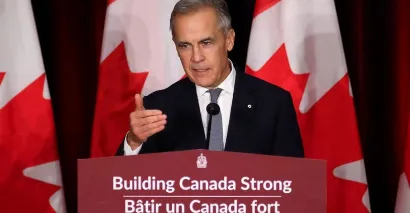Key Highlights
With the release of its Immigration Levels Plan for 2026–2028, Canada has made a dramatic change in the way it handles both temporary and permanent residents. Over the next two years, up to 33,000 people with work permits will have an expedited route to permanent residence, according to a federal announcement. Alongside this decision, there will be significant decreases in the number of temporary residents admitted each year, as well as consistent yearly goals of 380,000 permanent residents. The strategy demonstrates Ottawa's resolve to prioritise those who are already making contributions to Canadian communities while striking a balance between housing capacity and economic growth.
Highlights
-
33,000 work permit holders will transition to permanent residency between 2026 and 2027 through a new accelerated pathway
-
Canada will maintain 380,000 annual permanent resident admissions from 2026 through 2028, with 64% allocated to economic immigration
-
Temporary resident admissions drop 43% from 673,650 in 2025 to 385,000 in 2026, including major cuts to international student visas
-
Economic immigration receives priority with 239,800 spaces in 2026, rising to 244,700 in 2027-2028
Canada is making a deliberate transition from expansion to stability with its immigration policy for 2026–2028. On November 5, 2025, the federal government unveiled Budget 2025 and its most recent Immigration Levels Plan, which outlines goals to drastically cut temporary populations while maintaining steady admissions of permanent residents. The establishment of a simplified route for work permit holders who already have one in Canada is the most noteworthy aspect.
The goal of the plan, according to Immigration Minister Lena Metlege Diab, is to rebuild trust in Canada's immigration system. The government's strategy recognises the economic contributions of newcomers while also acknowledging the strain on public services, healthcare, and housing.
Also Read: PEI PNP Unscheduled Draw Invites 159 International Graduates
Accelerated Pathway for Work Permit Holders
The transition program for work permit holders is the main component of Canada's immigration strategy for 2026–2028. Up to 33,000 people with legitimate work permits will be granted permanent residency status during 2026 and 2027, according to Budget 2025. These workers actively support Canada's economy, pay taxes, and have developed close ties in their communities.
Since many temporary workers have essentially become permanent residents in all but legal status, officials characterise this as a practical measure. They cover vital roles in industries with ongoing labour shortages, such as technology, healthcare, and construction. The transition pathway gives employers and employees stability while also acknowledging their contributions.
Compared to the goals for 2025, which included more than 80,000 spaces for in-Canada transitions, this allocation is less. However, it signals continued government focus on converting temporary status to permanent residence for qualified candidates. The exact eligibility criteria and application process have not been fully detailed, but announcements are expected when the Immigration Minister tables the department's annual report.
Permanent Resident Admission Targets
Canada will welcome 380,000 new permanent residents annually from 2026 through 2028. This figure remains unchanged from previous projections and falls within a flexible range of 350,000 to 420,000. The consistency demonstrates the government's commitment to predictable immigration levels that align with available infrastructure.
The breakdown prioritises economic pathways over other categories. In 2026, approximately 239,800 permanent residents will arrive through economic immigration streams. This number increases slightly to 244,700 in both 2027 and 2028. Economic immigrants will constitute 64% of total permanent resident admissions in 2026, up from 59% in previous years.
|
Year |
Total PR Admissions |
Economic Class |
Family Class |
Refugee & Humanitarian |
|---|---|---|---|---|
|
2026 |
380,000 |
239,800 (63%) |
84,000 (22%) |
56,200 (15%) |
|
2027 |
380,000 |
244,700 (64%) |
84,000 (22%) |
51,300 (14%) |
|
2028 |
380,000 |
244,700 (64%) |
84,000 (22%) |
51,300 (14%) |
Family reunification targets decrease modestly to 84,000 in 2026, down from 88,000 in previous plans. Refugee and humanitarian admissions also face reductions, dropping to 56,200 in 2026 compared to earlier projections of 62,250.
Express Entry and Provincial Nominee Programs
Express Entry remains the primary vehicle for skilled worker immigration. The 2026-2028 plan maintains focus on two key Express Entry categories: Federal Economic Priorities and In-Canada Focus. Combined, these categories target approximately 124,680 admissions, representing growth from previous federal high-skilled allocations.
Federal Economic Priorities addresses in-demand occupations identified through category-based selection. This includes healthcare workers, skilled tradespeople, STEM professionals, and French-speaking candidates. The government conducted category-based draws throughout 2025 targeting these specific profiles, and this approach will continue under the new plan.
In-Canada Focus specifically targets individuals already residing in Canada on a valid temporary status. This category aligns with the government's preference for candidates with established Canadian connections. Workers holding valid permits, international students with Canadian credentials, and others demonstrating integration receive priority through this stream.
Provincial Nominee Programs are expected to receive increased allocations despite previous years' cuts. Throughout 2025, several provinces, including British Columbia, Manitoba, Saskatchewan, Newfoundland and Labrador, and New Brunswick, negotiated higher PNP quotas. The 2026 plan will likely reflect these agreements with targets potentially reaching 71,500 nominations, up from the notional 55,000 projected in earlier documents.
Sharp Reductions in Temporary Resident Admissions
The plan introduces dramatic decreases in temporary resident numbers. Canada will admit 385,000 new temporary residents in 2026, representing a 43% decline from 2025's target of 673,650. The government aims to reduce the temporary resident population to below 5% of Canada's total population by the end of 2027.
International student admissions face the steepest cuts. The 2026 target stands at 155,000, down 49% from 305,900 in 2025. Student visa numbers will remain suppressed at 150,000 annually in both 2027 and 2028. The government enforces these limits through caps on study permit applications, requiring Provincial Attestation Letters for most applicants.
|
Category |
2025 Target |
2026 Target |
Change |
|
Total Temporary Residents |
673,650 |
385,000 |
-43% |
|
International Students |
305,900 |
155,000 |
-49% |
|
Temporary Foreign Workers |
367,750 |
230,000 |
-37% |
Temporary foreign worker admissions decreased to 230,000 in 2026, down 37% from 367,750 in 2025. However, this represents an 8% increase compared to the 2026 target of 210,700 published in last year's plan. The adjustment recognises ongoing labour market demands while maintaining overall population management goals.
Francophone Immigration and Regional Distribution
Canada is accelerating francophone immigration outside Quebec. The plan increases French-speaking admissions from 9% of total immigration in 2026 to 10.5% by 2028. This translates to approximately 30,000 French-speaking permanent residents in 2026, rising to 35,000 by 2028.
The government supports this objective through multiple mechanisms. Category-based Express Entry draws specifically target French-language proficiency. The Francophone Mobility Program under the International Mobility Program provides work permit access for French speakers.
The 2026-2028 plan explicitly considers regional needs and rural community development. Budget 2025 states that immigration planning will account for "the unique needs of rural and remote communities" facing depopulation and labour shortages. Programs like the Rural and Northern Immigration Pilot and the Atlantic Immigration Program are expected to receive continued support.
Impact and What It Means for Applicants
The 2026-2028 plan creates both opportunities and challenges for people currently in Canada on temporary status. Work permit holders in priority occupations gain clearer pathways to permanence. However, the overall reduction in temporary admissions limits future arrivals.
International students face tighter restrictions. Post-Graduation Work Permit rules now require language ability verification and alignment with in-demand fields. Spouse open work permits are limited to partners of high-skilled workers and graduate-level students.
|
Stakeholder Group |
Response |
Key Concerns |
|
Immigration Lawyers |
Critical |
System capacity, processing delays |
|
Business/Labour Groups |
Mixed |
Worker shortages in key sectors |
|
Housing Advocates |
Supportive |
Alignment with housing supply |
|
Post-Secondary Institutions |
Concerned |
Reduced international student revenue |
Individuals planning Canadian immigration should understand how the plan affects various pathways. Economic immigration remains the strongest avenue, particularly for candidates with skills in priority occupations. Healthcare workers, skilled tradespeople, and STEM professionals enjoy the best prospects. French language ability significantly enhances eligibility across multiple streams.
Conclusion
Canada's Immigration Levels Plan for 2026-2028 charts a careful course between economic necessity and social capacity. The decision to transition 33,000 work permit holders to permanent residency recognises contributions from those already integrated into Canadian communities. These individuals fill critical positions, pay taxes, and demonstrate commitment to Canada's future.
The stable permanent resident target of 380,000 annually provides predictability for provinces, employers, and service providers. Economic immigration's dominant share ensures continued talent attraction in priority sectors. Temporary resident reductions address public concerns about population growth outpacing housing supply.
Canada maintains its position as a welcoming immigration destination while acknowledging real constraints. The 2026-2028 plan attempts sustainable immigration that newcomers, receiving communities, and Canadian institutions can manage effectively.
To learn more about the latest immigration news, contact TerraTern right away!








